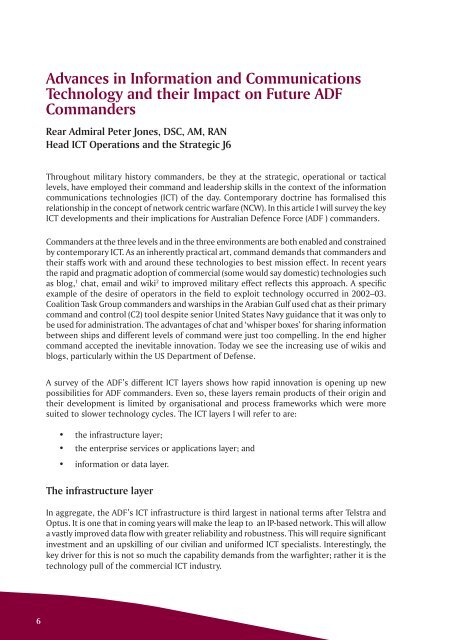ISSUE 176 : Jul/Aug - 2008 - Australian Defence Force Journal
ISSUE 176 : Jul/Aug - 2008 - Australian Defence Force Journal
ISSUE 176 : Jul/Aug - 2008 - Australian Defence Force Journal
You also want an ePaper? Increase the reach of your titles
YUMPU automatically turns print PDFs into web optimized ePapers that Google loves.
Advances in Information and Communications<br />
Technology and their Impact on Future ADF<br />
Commanders<br />
Rear Admiral Peter Jones, DSC, AM, RAN<br />
Head ICT Operations and the Strategic J6<br />
Throughout military history commanders, be they at the strategic, operational or tactical<br />
levels, have employed their command and leadership skills in the context of the information<br />
communications technologies (ICT) of the day. Contemporary doctrine has formalised this<br />
relationship in the concept of network centric warfare (NCW). In this article I will survey the key<br />
ICT developments and their implications for <strong>Australian</strong> <strong>Defence</strong> <strong>Force</strong> (ADF ) commanders.<br />
Commanders at the three levels and in the three environments are both enabled and constrained<br />
by contemporary ICT. As an inherently practical art, command demands that commanders and<br />
their staffs work with and around these technologies to best mission effect. In recent years<br />
the rapid and pragmatic adoption of commercial (some would say domestic) technologies such<br />
as blog, 1 chat, email and wiki 2 to improved military effect reflects this approach. A specific<br />
example of the desire of operators in the field to exploit technology occurred in 2002–03.<br />
Coalition Task Group commanders and warships in the Arabian Gulf used chat as their primary<br />
command and control (C2) tool despite senior United States Navy guidance that it was only to<br />
be used for administration. The advantages of chat and ‘whisper boxes’ for sharing information<br />
between ships and different levels of command were just too compelling. In the end higher<br />
command accepted the inevitable innovation. Today we see the increasing use of wikis and<br />
blogs, particularly within the US Department of Defense.<br />
A survey of the ADF’s different ICT layers shows how rapid innovation is opening up new<br />
possibilities for ADF commanders. Even so, these layers remain products of their origin and<br />
their development is limited by organisational and process frameworks which were more<br />
suited to slower technology cycles. The ICT layers I will refer to are:<br />
• the infrastructure layer;<br />
• the enterprise services or applications layer; and<br />
• information or data layer.<br />
The infrastructure layer<br />
In aggregate, the ADF’s ICT infrastructure is third largest in national terms after Telstra and<br />
Optus. It is one that in coming years will make the leap to an IP-based network. This will allow<br />
a vastly improved data flow with greater reliability and robustness. This will require significant<br />
investment and an upskilling of our civilian and uniformed ICT specialists. Interestingly, the<br />
key driver for this is not so much the capability demands from the warfighter; rather it is the<br />
technology pull of the commercial ICT industry.<br />
6

















